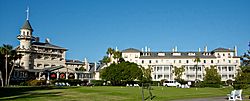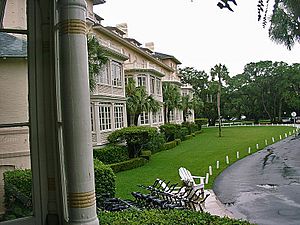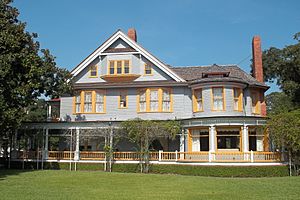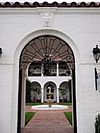Jekyll Island Club facts for kids
|
Jekyll Island Club Historic District
|
|

Club House and Annex
|
|
| Location | Jekyll Island, Georgia |
|---|---|
| Area | 240 acres (97.1 hectares) |
| Built | 1884-1930 |
| Architect | Multiple |
| Architectural style | Queen Anne |
| NRHP reference No. | 72000385 |
Quick facts for kids Significant dates |
|
| Added to NRHP | January 20, 1972 |
| Designated NHLD | June 2, 1978 |
The Jekyll Island Club was a very special private club located on Jekyll Island, which is on Georgia's Atlantic coast. It started in 1886 when a group of wealthy people bought the island for $125,000. That would be like $3.1 million today! The main building, called the Clubhouse, was finished in 1888.
This club became very popular in the early 1900s. Its members were some of the richest families in the world, like the Morgans, Rockefellers, and Vanderbilts. The club had to close at the end of 1942 because of problems caused by World War II.
In 1947, the state of Georgia bought the island from the club members for $675,000 (about $7.4 million today). The state tried to run the club as a public resort, but it didn't work out very well. So, the whole place closed down by 1971.
However, the complex was named a historic landmark in 1978. This meant it was a very important place in history. It was then fixed up and reopened in 1985 as a fancy hotel. Today, the Jekyll Island Club Hotel is part of Historic Hotels of America. This is a program that recognizes important historic hotels.
Contents
How the Club Started
After the time of big plantations on Jekyll Island, a man named Newton Finney had an idea. He suggested to his brother-in-law, Dubignon, that they buy the island. Then, they could sell it to rich people from the North as a place to visit in the winter. A banker from New York helped them buy the whole island. By 1885, Dubignon owned all of Jekyll Island.
In 1885, Finney and his friend Oliver K. King gathered a group of men. They officially started the "Jekyl Island Club" on December 9, 1885. They planned to sell 100 shares of the club's stock to 50 people. Each share cost $600, which would be about $15,000 in today's money!
Finney found it easy to sell the shares. Many famous people joined the club. These included Henry Baldwin Hyde, Marshall Field, John Pierpont Morgan, Joseph Pulitzer, and William K. Vanderbilt.
On February 17, 1886, Finney and Dubignon made a deal. Dubignon sold Jekyll Island to Finney's club for $125,000. A meeting was held in New York to create the club's rules and choose its leaders. The first president was Lloyd Aspinwall. These new leaders had a big job: to turn the wild island into a fancy social club for America's richest people.
Sadly, Lloyd Aspinwall died just five months after becoming president. Henry Howland then took over as the club's president.
Teams were put together to get the club ready. Charles A. Alexander was chosen to design the main clubhouse. Horace William Shaler Cleveland, a famous landscape architect, designed the beautiful grounds.
Building the clubhouse began in August 1886. It was finished by November 1. The club officially opened its doors for the 1888 season on January 21.
Some very important events happened on Jekyll Island during the club's time. In 1915, the first phone call across the entire country was made from here! Theodore N. Vail, who was the president of AT&T, called Alexander Graham Bell, Thomas A. Watson, and President Woodrow Wilson. Also, in 1908, a plan for a new banking system for the United States was created here.
Fun Times at the Club
The Jekyll Island Club was a special kind of resort. It was more focused on families than other clubs of its time. It was very popular among the rich and stayed very exclusive for 60 years.
When the club first started, hunting was a main activity. A gamekeeper made sure the island had plenty of pheasants, turkeys, quail, and deer.
Members had to report what they hunted each day and give it to the club. Wild game was often served on the clubhouse menu. There was even a taxidermist shop at the club to mount the animals members hunted.
As the club grew, other fun activities became popular. Golf eventually became the most popular sport. The first golf course was just north of the club. Later, in the 1920s, a course was built by the ocean. Part of this old golf course is still there today, and you can play on it!
Other fun things to do included carriage rides, tennis, and bicycling.
Jekyll Island and the Federal Reserve
Jekyll Island was the secret location of a very important meeting in November 1910. At this meeting, a plan was written to create a central banking system for the United States. After a financial crisis in 1907, people realized the U.S. needed a better banking system.
Senator Nelson Aldrich studied banking systems in Europe for almost two years. When he came back, he brought together many of the country's top bankers to Jekyll Island. They met to talk about money and banking. They wrote a plan called the "Aldrich Plan." Some ideas from this plan were later used to create the Federal Reserve Act. This act created the Federal Reserve, which is like the central bank of the U.S.
On November 22, 1910, Senator Aldrich and other powerful financial leaders left New York on a train. They traveled in complete secrecy, using only their first names or code names. They didn't want anyone to know who they were. Their excuse for the trip was a duck hunting trip on Jekyll Island.
Forbes magazine founder Bertie Charles Forbes later wrote about this secret meeting. He said it was "the strangest, most secret expedition in the history of American finance." He explained that they were kept hidden on Jekyll Island until they had created a new banking system for the United States. This plan was the real start of the Federal Reserve System we have today.
The Club's End
The Great Depression in 1929 brought big changes to Jekyll Island. This difficult time affected even the very rich. Being a member of an exclusive club became too expensive for many. The number of members slowly dropped through the 1930s.
As the club's money problems got worse, they tried something new in 1933. They created a cheaper "Associate membership" to attract new and younger people. This helped for a little while, but not for long.
World War II was the final blow for the Jekyll Island Club. The club opened for the 1942 season as usual. But by March, they announced an early closing. This was because of money problems and the difficulty of finding workers during the war. The 1942 season turned out to be the very last for the Jekyll Island Club.
The club's president hoped it could reopen after the war. However, in 1946, the state of Georgia decided to buy the island. The state wanted to turn one of Georgia's barrier islands into a public state park. On June 2, 1947, the state bought the island for $675,000.
The state tried to run the club as a public resort, but it didn't make enough money. It closed by 1971. In 1978, it was made a historic landmark. Then, in 1985, it was restored and reopened as a hotel. Today, it is known as the Jekyll Island Club Resort.
Famous Members of the Club
When the club first started, it only allowed 100 members to keep it very exclusive. During the Great Depression, they created a new "Associate Membership" for up to 150 people. These members paid less but still got all the benefits.
Here are some of the most well-known members:
| Member | Biography | Years |
|---|---|---|
| Nelson W. Aldrich | American politician, his daughter married John D. Rockefeller Jr. | 1912-1915 |
| George Fisher Baker | Founder of First National Bank, which later became part of Citibank | 1901-1931 |
| Cornelius Newton Bliss | A successful businessman and politician | 1886-1911 |
| Matthew Chaloner Durfee Borden | Known as the "Calico King" for his textile business | 1892-1912 |
| Frederick Gilbert Bourne | President of the Singer Manufacturing Company (sewing machines) | 1901-1919 |
| Robert Brewster | Son of Benjamin Brewster, an early investor in Standard Oil | 1912-1939 |
| William Bayard Cutting | A lawyer, financier, and real estate developer | 1886-1912 |
| Charles Deering | A businessman and art collector | 1887-1902 |
| James Ellsworth | A coal mine owner and financier | 1915-1924 |
| Marshall Field | Founder of the famous Marshall Field's department stores | 1886-1906 |
| Ogden Goelet | A New York real estate developer | 1886-1897 |
| Edwin Gould | Son of railroad builder Jay Gould | 1899-1933 |
| George Jay Gould I | Also a son of railroad builder Jay Gould | 1895-1916 |
| Edward S. Harkness | A philanthropist whose father invested in Standard Oil | 1911-1923 |
| James J. Hill | A railroad executive, known as the "Empire Builder" | 1888-1916 |
| Alanson Houghton | A businessman and diplomat | 1919-1941 |
| Morris Ketchum Jesup | A banker and philanthropist | 1888-1908 |
| John Stewart Kennedy | A banker and philanthropist | 1898-1909 |
| Thomas W. Lamont | A powerful banker at J.P. Morgan & Co. | |
| Pierre Lorillard IV | Heir to the Lorillard Tobacco Company | 1886-1886, 1888-1891 |
| Cyrus Hall McCormick Jr. | Head of the McCormick Harvesting Machine Company | 1891-1936 |
| JP Morgan | A famous financier who created U.S. Steel and General Electric | 1886-1913 |
| J. P. Morgan Jr. | Son of J.P. Morgan, also a banker and philanthropist | 1913-1943 |
| Joseph Pulitzer | A journalist famous for the Pulitzer Prizes | 1886-1911 |
| William Rockefeller | Co-founder of Standard Oil with his brother John D. Rockefeller | 1905-1922 |
| Samuel Spencer | President of the Southern Railway | 1898-1906 |
| Theodore Newton Vail | President of American Telephone and Telegraph | 1912-1920 |
| Cornelius Vanderbilt II | Grandson of "The Commodore" Cornelius Vanderbilt, built wealth in shipping and railroads | |
| William Kissam Vanderbilt | Also a grandson of Cornelius Vanderbilt, inherited a large fortune | 1886-1902 |
Associate Members (started in 1933):
| Member | Years |
|---|---|
| William Truman Aldrich | 1933-? |
| John Foster Dulles | 1933-? |
| David Sinton Ingalls | ? |
| Julian Myrick | ? |
| George Herbert Walker | 1933-? |
Club Presidents
Here are the people who led the Jekyll Island Club:
- 1886–1887 — Lloyd Aspinwall
- 1887–1896 — Henry Howland
- 1897–1914 — Charles Lanier
- 1914–1919 — Frederick Bourne
- 1919–1927 — Dr. Walter James
- 1927–1933 — Walter Jennings
- 1933–1938 — J.P. Morgan Jr.
- 1938–1942 — Bernon Prentice
Jekyll Island Club Historic District
The Jekyll Island Club Historic District is a special area on the National Register of Historic Places (NRHP). It's also a National Historic Landmark District. This means it's recognized as a very important historical place in the United States. It's located on the west side of Jekyll Island in Glynn County, Georgia. The district covers 240 acres (about 97 hectares).
It includes many important buildings from the old Jekyll Island Club. Two of these, the Rockefeller Cottage and Faith Chapel, are even listed separately on the NRHP. The Jekyll Island Club Historic District was added to the NRHP on January 20, 1972. It became a national historic landmark district on June 2, 1978.
From 1967-1968, a landscape architect named Clermont Huger Lee made a big plan. Her goal was to bring the area known as “Millionaire’s Village” back to how it looked between 1910 and 1929. Even though her full plan wasn't used, her ideas helped a lot in fixing up today's Jekyll Island Historic District.
Important Buildings in the District
Here are some of the important buildings that are part of the historic district:
| Key: |
|---|
| Listed separately on the National Register of Historic Places |
| Not part of the original historic club (newer buildings) |
| No longer standing (demolished) |
| Name | Image | Year Built | Notes |
|---|---|---|---|
| Baker-Crane Carriage House |  |
Around 1890 | This building was for carriages and horses. It was built for Frederic Baker. |
| Boat Engineer's Cottage |  |
1916 | The club built this house for its boat engineer. Today, it's a gift shop. |
| Bookkeeper's Cottage (Stephens Cottage) |  |
1900 | Built for the club's bookkeeper. Now it's The Cottage Gift Shop. |
| Chauffeurs' Dormitory |  |
1905 | This building housed the drivers (chauffeurs) for the wealthy members. Today, it has a gift shop and the Jekyll Island Post Office. |
| Cherokee Cottage (Shrady-James Cottage) |  |
1904 | Built for George Frederick Shrady Sr. Later owned by Dr. Walter Belknap James. |
| Club House |  |
1887 | The main building of the Jekyll Island Club. It's now the Jekyll Island Club Resort. |
| Club House Annex |  |
1901-1903 | This building had apartments and guest rooms for club members. |
| Commissary |  |
Around 1900 | This was likely a store or supply building for the club. Now it's a handicrafts shop. |
| Crane Cottage |  |
1917-1918 | A beautiful cottage built for Richard Teller Crane Jr. |
| DuBignon Cottage (Club Cottage) |  |
1884 (moved 1896) | This is the only building that was on the island before the club started in 1886. It was moved to its current spot. |
| Faith Chapel |   |
1904 (renovated 1970) | A beautiful chapel with gargoyles like those on Notre-Dame in Paris. It also has a famous stained-glass window by Louis Comfort Tiffany. |
| Furness Cottage |  |
1889-1891 (renovated later) | Built for Walter Rogers Furness. It was also used as the Jekyll Island Infirmary (a small hospital). |
| Georgia Sea Turtle Center (Jekyll Island Power Plant) |  |
Around 1903 (renovated 2006) | This building used to be the power plant for the island. Now it's the Georgia Sea Turtle Center, which opened in 2007. |
| Goodyear Cottage |  |
1903-1906 (renovated 1973) | A large cottage built for the Goodyear family. |
| Gould Casino Auditorium |  |
1902 (remodeled 1957) | Built by Edwin Gould as indoor tennis courts. |
| Hollybourne Cottage |  |
1890 | Built for Charles Stewart Maurice. It's made of a special material called tabby concrete. |
| Jekyll Island Authority Administration Building |  |
This building used to be a dormitory for married servants. Now it holds offices for the Jekyll Island Authority. | |
| Jekyll Island Authority Offices |  |
This building was a dormitory for single servants. | |
| Jekyll Island Museum (Club Stables) |  |
1897 (renovated 2017-2019) | This used to be the stables for the club's horses. It reopened as the Jekyll Island Museum in 2019 after a big renovation. |
| Jekyll Island U.S. Post Office |  |
This is located in the back of the Chauffeur's Dormitory building. | |
| Mistletoe Cottage (Claflin-Porter Cottage) |  |
1900 | Built for Henry Kirke Porter. John Claflin bought it later. |
| Morgan Tennis Court |  |
1930 | Named after J. P. Morgan Jr., who was the club president. |
| Moss Cottage |  |
1896 | Built for William Struthers Jr. |
| Pump House |  |
Around 1925 | This building likely helped pump water for the club. |
| Rockefeller Cottage (Indian Mound Cottage) |  |
1892 (expanded around 1910) | Built for Gordon McKay and later bought by William Rockefeller. |
| San Souci Apartments |  |
1896 | Built by Henry Baldwin Hyde as a building with six apartments. J. P. Morgan owned one of them! |
| San Souci Boiler House |  |
1896 | This building provided heat and hot water for the San Souci Apartments. Now it's the Island Sweets Shoppe. |
| Solterra Dovecote |  |
Around 1890 (restored 2016) | This small building was for doves. It survived a fire that destroyed the main Solterra Cottage. |
| Staff Dining Hall |  |
Around 1910 | This was where the club's staff ate their meals. Now it's a shop called Remember When. |
| Villa Marianna |  |
1929 | Built for Frank Miller Gould and named after his daughter. |
| Villa Opso |  |
1927 | Built for Walter Jennings. Its name comes from the old Guale name for Jekyll Island. |
| Wharf (Jekyll Landing Wharf) |  |
This was the dock where boats would arrive at Jekyll Island. |
Buildings No Longer Standing or Not Part of the Original Club
Here are some buildings that were either torn down or are newer additions to the area:
See also




























